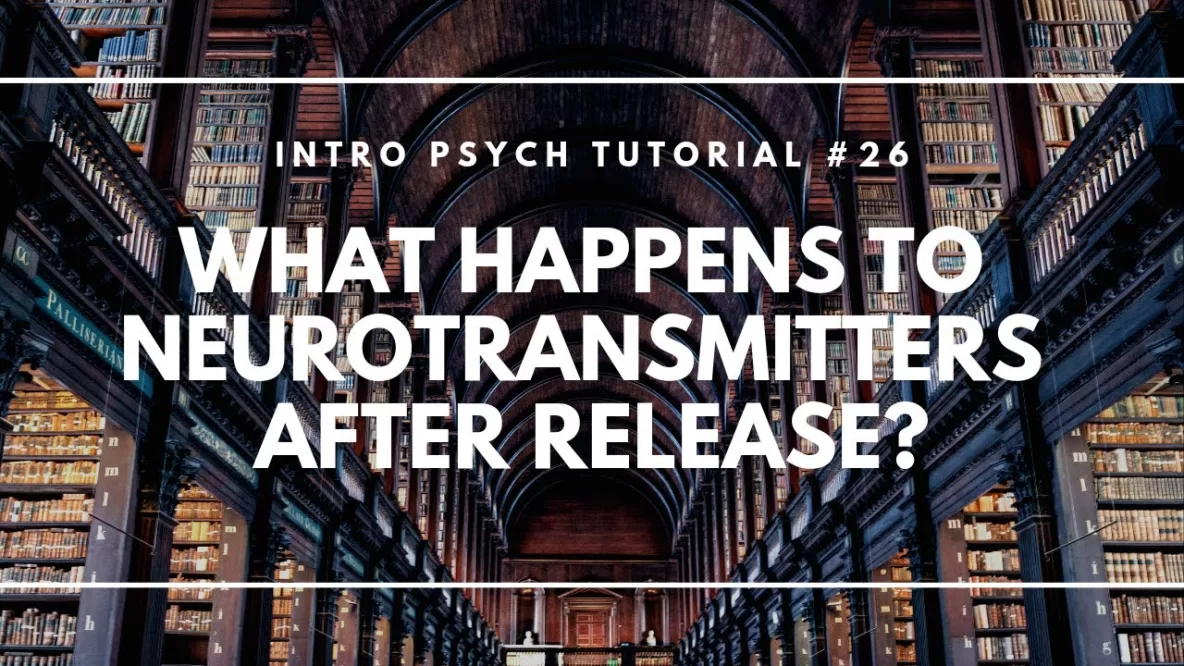In this video I explain what else can happen to a neurotransmitter after release (besides binding to a receptor on the postsynaptic neuron). These include reuptake, enzyme deactivation, and autoreception, and I provide mnemonics for remembering each of these processes.
Don’t forget to subscribe to the channel to see future videos! Have questions or topics you’d like to see covered in a future video? Let me know by commenting or sending me an email!
Need more explanation? Check out my full psychology guide: Master Introductory Psychology: http://amzn.to/2eTqm5s
Video Transcript:
Hi, I’m Michael Corayer and this is Psych Exam Review and in this video I’m going to talk about what happens to the neurotransmitter after it’s been released into the synapse.
In the last video, I talked about how two neurons communicate with one another and they do this at the synapse which is this gap between the presynaptic neuron here and the postsynaptic neuron. So the terminal button of the presynaptic neuron releases neurotransmitter from these vesicles and this neurotransmitter flows across the synapse and on the postsynaptic neuron, this would be the dendrite of the postsynaptic neuron, the neurotransmitter binds to receptor sites and this influences whether or not the postsynaptic neuron will fire.
So you might be wondering, what about any extra neurotransmitter that’s left here? It’s just kind of floating across, not all of it is going to find a receptor site on the postsynaptic neuron. So what do we do about this extra neurotransmitter? We can’t have it just sitting in the synapse because it could then influence this next neuron when we don’t really want it to, when we’re not trying to send a message.
So there’s three things that happen to sort of maintain the synapse here. And the first thing that can happen is that the presynaptic neuron has channels on it. And what these channels essentially do is they suck up the neurotransmitter and this is called reuptake. These channels can draw the neurotransmitter back into the presynaptic neuron and when it’s drawn back inside then it can be put back inside vesicles and reused. So this is sort of the vacuum cleaner approach to clearing the synapse. We suck the neurotransmitter back into the presynaptic neuron and we reuse it later.
Another thing that can happen is, the neurotransmitter is floating around in the synapse here and there’s other stuff floating around here too. There could be other neurotransmitters from nearby cells, there could be drugs in here there could be hormones but one thing that you’ll also find in here is you’ll find enzymes. This is not really what they look like. What the enzymes do is they float around in here and they deactivate the neurotransmitter. So a certain enzyme will deactivate a particular neurotransmitter. It can break it down into waste products or it can break it down into parts that might be recycled.
So we have this sort of Pacman approach where the enzyme comes through synapse and eats up all these little bits of neurotransmitter and breaks them down. So this is the Pacman approach.
The last technique we have doesn’t really clear the neurotransmitter out but it helps maintain the right level of new transmitter in this synapse and this is actually receptor sites on the presynaptic neuron. So there’s receptor sites on the postsynaptic neuron but this cell can also detect how much neurotransmitter it’s releasing. So it sort of has a monitor here and what this monitor is doing is checking how much neurotransmitter is there. This is a process known as autoreception.
So you can think of autoreception like the thermostat in your house. So it monitors the heat in your house and when the heat reaches some particular level it turns the heater off. “OK that’s warm enough” and the same will be true for the neurotransmitter here, so the autoreception is detecting how much neurotransmitter is there and when it reaches a certain level it can actually inhibit the presynaptic neuron from releasing any more of the neurotransmitter. This will ensure that we don’t have too much there. So we have the appropriate level and some of it’s going to get taken back up by reuptake. Some of it’s going to get broken down by enzymes, and some of it is going to bind to postsynaptic neuron receptors. Actually while we have the red here we can make this into a Mrs. Pacman.
So those are our three main approaches. We have the vacuum cleaner, reuptake, we have the Pacman or the Mrs Pacman, eating up the neurotransmitter, the enzyme breaking it down and we have the thermostat approach, which is autoreception, monitoring the level of neurotransmitter ensuring that doesn’t get too high, inhibiting release of more neurotransmitter.
So I hope you found this helpful. If so please like the video and subscribe to the channel for more. Thanks for watching!

